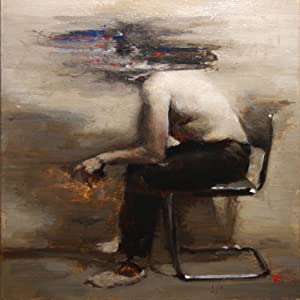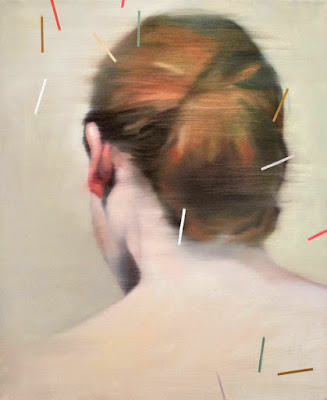When painters efface the surface of a portrait, they typically leave the eyes in a carefully finished state, both because of the psychological importance of the eyes, and to show that they're capable of painting realistically.
But not always. Sometimes artists deliberately disrupt the mouth, eyes, or head.

Artist Zack Zdrale says in the book Disrupted Realism, "I've taken passages of traditionally rendered figures and smashed them, breaking the illusion of form in space. I want to show the paint doing things that only paint can do."
Michelle Kohler
Michelle Kohler says: "Most of my years spent studying were focused on portraiture, as expressed through realism. As an artistic discipline, it has been a constant throughout my life. But it was only after a fortuitous departure into abstract painting that I was able to playfully and courageously combine two disciplines. Deconstructed Realism is my expression of artistic independence and creativity as it pertains to the depth and complexity of human portraiture."
(Link to YouTube) Mia Bergeron says that her approach to painting grew out of a frustration with the academic approaches to realism.
The deconstructive approach includes not just figural work, but also landscapes and cityscapes.
Other artists that you've suggested to check out in the comments: Julie T. Chapman, Patrick Kramer, Jenny Saville,
Book: Disrupted Realism: Paintings for a Distracted World











Seems to me that some of this stuff is gimmickry to get noticed. John Wentz work looks like the Barf emoji.
ReplyDeleteThanks for this great post. I especially like the painting of the house. To my eye it speaks volumes, with only a greeting card's amount of information.
ReplyDeleteI believe many of the artists painting in this manner were heavily influenced by Kanevsky , who resists being labeled or lumped into a movement , given a name from the need to name and label . Frazetta didn't like being labeled a fantasy artist , as if he were a member of a group or school - when he was the one who largely created it , or at least brought it back from the turn of the century . A lot of great artists like Wyeth and Schmid had abstract passages in their work .
ReplyDelete"Deconstructed Realism" I had never heard that term before. I have done some paintings I think could be said to be in that style, I've never known what to call it before.
ReplyDeleteNone of these strike me as particularly ‘abstracted’ even though they are exploring abstract techniques and qualities of the paint medium. I see them more as ‘deconstructed’ images.
ReplyDeleteI am curious as to the ‘Zeitgeist’ that is being expressed by deconstructing forms in space and revealing or exposing the textures and qualities of the painted medium of abstract expressionism. I’ve been reading about the development of the new ’Standard Model’ in sub-atomic physics and how strange it all is down their beneath our ‘Newtonian’ world view.
I like Mia Bergeron and Jeremy Mann;
markers is right about Went.
Great Post James. -RQ
I'm curious if the book includes any work by Jenny Saville, whose portraits would probably qualify under this "ism." (A term that I kind of hate, incidentally, but hey--we gotta have labels.) Saville has an interesting exhibition in Italy right now, and was featured in the NYT today.
ReplyDeleteI really love this style, i think the abstract parts give intensity to the detailed parts: i'd say Mann's portraits would lose a lot if they were entirely realistic. But i've some doubt about the inclusion of Gregory Manchess in this group: while he obviously has a lot in common with other artists you mentioned, from what i understood of his way of thinking (i absolutely love his style and i try to follow him whenever i can) he's more focused on giving the idea of planes of the bodies than actually rendering them in an abstract way (even if i'd say that in the example you showed he really pushed the abstract part of the work till the limit). The final effect looks almost the same, but i'd say the goal is completely different: not transforming a realistic image in something abstract but , on the contrary, creating something realistic from abstract shapes. He's an illustrator besides a painter, after all. But i realize this is my personal view of his work. Thanks for this insight in this particular style!
ReplyDeleteFechin comes to mind. Also Van Gogh's portraits. Generally the face is intact in their works though. The first to performatively 'disrupt' the face while working in a somewhat realistic style may be Francis Bacon.
ReplyDeleteLuca, you're right: Greg Manchess's painting was a commissioned illustration for a pharmaceutical ad campaign where he used the technique to express "Artistic interpretations of psychiatric disorders, used in a campaign for a medical treatment." But I don't that origin should disqualify it from being considered along with other works. Like the other artists, he's capable of painting a fully realistic image, but he's intentionally making parts of the image incoherent.
ReplyDeletePatrick Kramer is my new favorit in this type of genre. A must watch.
ReplyDeleteYou can have a lot of fun with paint and these paintings exemplify that.
ReplyDeleteThanks so much for sharing this commentary and links to the book/videos. I've tumbled down the abstract rabbit hole in my work for some months now and am enjoying it but having painted representationally before, I have a tendency is to try to incorporate elements that suggest something that "feels familiar"…"disrupted realism" feels like an interesting path to explore between realistic and purely abstract work. There is an artist named Julie T. Chapman who paints animals in this style and her work is lovely. https://www.julietchapman.com
ReplyDelete